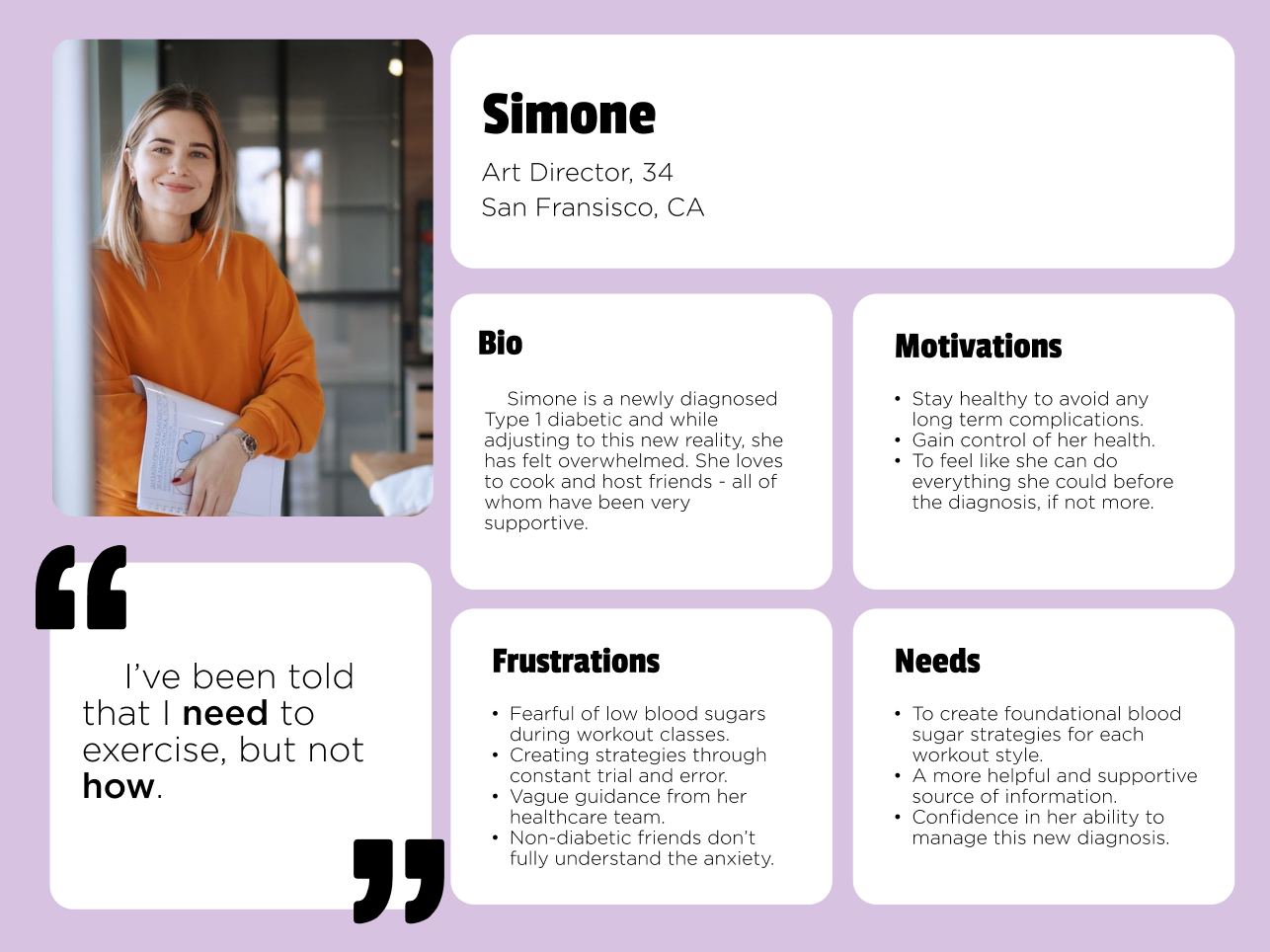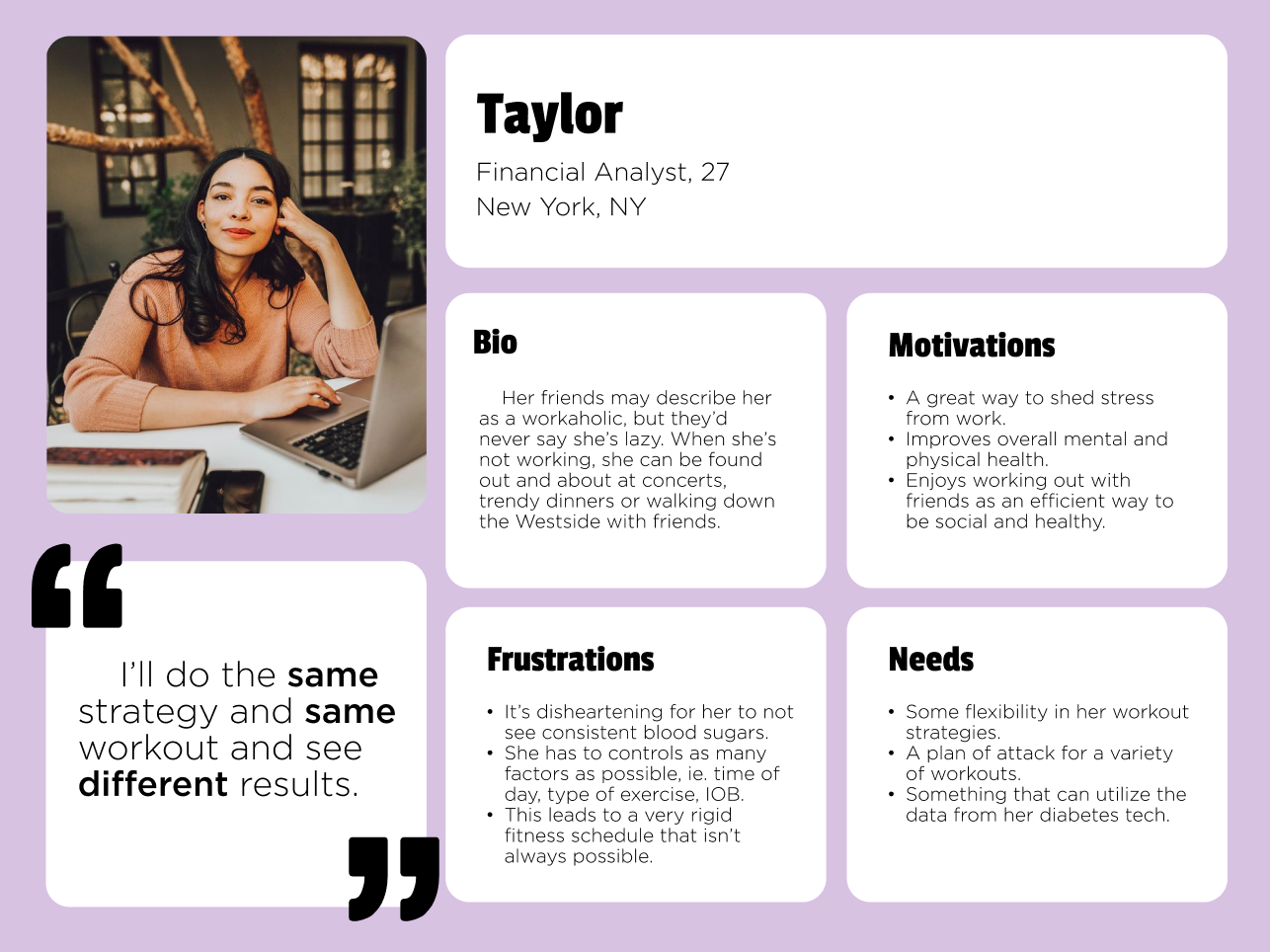DIALOG
Mobile based website that allows users to view workout stats along with diabetic data for a more holistic understanding of blood sugar patterns.
PROJECT BRIEF
Mobile first website
ROLE
UX Research, UX/UI Design
PROJECT DURATION
120 hours
THE PROBLEM
For Type 1 diabetics, managing blood sugar is a full-time job. One aspect that is particularly difficult to manage is exercise. Type of workout, insulin on board, and time of day can all impact blood sugar levels in different ways.
Healthcare teams emphasize the positive impact that regular exercise has on insulin sensitivity, weight, and overall health, yet finding strategies to manage blood sugar is left up to the individual.
RESEARCH OBJECTIVES
Determine baseline knowledge of the effects of exercise on blood sugar
Learn current tracking methods, if any
Understand stressors, hesitations, and pain points around exercise
Discover ideal fitness routine and goals
METHOD #1: COMPETITOR ANALYSIS
There are a wide variety of diabetic companies on the market that are aimed at identifying blood sugar patterns and improving users’ T1D management. I researched some of the most popular in order to understand how they address and track exercise.
METHOD #2: USER INTERVIEWS
In-depth interviews with Type 1 Diabetics, aged 25-45, who currently exercise or would like to start. The goal was to learn how they manage exercise both physically and mentally so that I could understand how to improve their confidence and knowledge.
MARKET RESEARCH
I found the majority of diabetic health companies are focused on carb counting and food education with little attention to activity. They allow users to log the date and time of their exercise without further detail about type of workout or insulin on board.
RESEARCH FINDINGS
I found that everyone, from recently diagnosed to veteran T1D, had experienced similar frustrations and anxieties surrounding exercise. They did not want diabetes to stop them from reaching their fitness goals, but repeatedly felt discouraged from the lack of predictability.
COMMON PAIN POINTS
INABILITY TO PREDICT BLOOD SUGAR OUTCOMES
Interviewees expressed frustration that they would perform the same workouts and have different outcomes. This commonly resulted in anxiety around trying new activities.
RIGIDITY IN FITNESS ROUTINE
Participants stated they were most comfortable working out under familiar circumstances, including time of day, type of workout, and food consumption. Because of this they felt little flexibility in their schedule.
LACK OF EDUCATION
T1Ds were having to seek out tips and strategies to bolster foundational knowledge. Majority found the T1D community most helpful as it provided first-hand experiences and strategies.
Based on these reoccurring frustrations, I created personas that encapsulated two main aspects: those whose lack of education has made it intimidating to start and those who struggled to find proven, successful strategies for their current fitness routine.


There are a lot of emotions entangled with exercise, they could swing from joy to frustration over the course of a single workout. It was clear that they needed something to help relieve their mental workload in order to enjoy the workout.
This lead me to consider:
HOW MIGHT WE…
increase flexibility in their fitness routines while decreasing anxiety?
use pattern tracking to mitigate fear around out of control blood sugars?
assist in creating a baseline strategy for different workout types?
IDEATION
The first step in building a successful blood sugar strategy is identifying patterns. Does their blood sugar drop after 30 minutes of running? Do they experience a sharp spike during HIIT workouts? I wanted to create a tool that would take the workload of tracking off of their memory and onto technology.
WIREFRAMING
I began sketching solutions and constantly reevaluated them against the problem statements to ensure the user was being prioritized. I narrowed in on a few clear opportunities:
INTEGRATION OF DIABETIC TECH + FITNESS APPS
For those utilizing CGMs and insulin pumps, there is a natural progression to then integrate these with fitness apps, such as Strava, for a holistic view of activity and blood sugar trends.
ABILITY TO TRACK BLOOD SUGAR
All of those interviewed utilized fitness tracking apps to record past activity, yet when it came to tracking blood sugar patterns, they relied solely on their memory and routines.
EDUCATION BASED ON REAL WORLD RESULTS
Hormones, amount of sleep, and insulin sensitivity are only a few silent factors that can affect blood sugar. Having the ability to notice patterns and would allow users to predict instead of react.
BUILDING THE BRAND
Modern medical and health companies are creating more approachable brand identities that help ease the fear and anxiety users may have around healthcare.
I wanted to convey a sense of lightheartedness without being too playful by using pops of color and avoiding sterile fonts.
There is still a seriousness that is necessary to gain the user’s trust, especially regarding their health, so the brand voice should be friendly but knowledgeable.
LOGO DESIGN
I wanted the logo to feel clean and modern without being boring. I incorporated the teardrop to signify a bead of sweat or drop of blood.
KEY FUNCTIONS
STREAMLINED ACTIVITY LOGS
The option of importing data directly from fitness and diabetic health accounts will result in more accurate activity in less time.
RATING STRATEGIES FOR FUTURE REFERENCE
By creating a database of past activity, users are able to quickly identify strategies that have worked for them, as well as avoid those that have been dangerous or ineffective.
TESTING OBJECTIVES
VALIDATE ACTIVITY LOG DATA FIELDS
While time and ease of completion are factors to be noted, I wanted to focus on the content. By gathering the correct data, I can ensure that the user is logging information that is relevant in solving their problem.
DETERMINE EASE OF REFERENCING PAST DATA
Users can seamlessly find their past activity and filter accordingly. If the user is unable to easily access their health stats then there is no point in logging the data to begin with.
OBSERVE USER’S NATURAL FLOW
Ensuring that verbiage and IA aligned with users’ expectations.
USABILITY RESULTS
I found there were 3 main issues that were causing users delays and confusion when trying to complete their tasks:
01. Confusion with site navigation and architecture
02. Limited rating scale of success
03. Ambiguous badge icon
ITERATIONS
I reevaluated the designs focusing on alleviating these roadblocks to provide the user a more informative and seamless experience.
REORGANIZATION OF NAVIGATION
I consolidated all account and activity information under the profile icon which was where users gravitated during testing.
Secondary features like educational resources and FAQs were then grouped under the hamburger menu.
MORE INCLUSIVE RATING SYSTEM
The binary rating system did not allow for a spectrum of unsuccessful strategies. A strategy that needs slight adjustments should not be categorized the same as one resulting in a dangerous blood sugar.
Adding a scale of options allows users to have a more detailed record of each workout.
CREATING A USER DASHBOARD
While users have the option to find activity under their profile, I also wanted to create a landing page that offered at-a-glance insights and common task flows.
EASY TO UNDERSTAND ICONS
With the widened rating scale, there was opportunity to create a more comprehensible and accessible icon using both design and color variation.
The face icon is more universally understood and the colors allow for users to quickly identify the success level.
FINAL PROTOTYPE
NICE TO HAVES
Future-thinking, I wanted to include ideas that came up during testing. These are not critical for user’s success in performing tasks, but could positively add to the user experience.
CREATING A “WORKOUT PREDICTOR”
After users compiled enough data, they would be able to enter their workout details and see a recommended strategy based on past successes.
ADDING A FOOD LIBRARY
As so much of the form can be imported, it would be nice to allow users to create a food library within their profile of common snacks. They could utilize a dropdown or autofill function within the form to allow for quick and accurate data.
CONCLUSION
Moving forward, I would love to expand the research pool to those not utilizing CGMs or pumps. T1D management is highly individual so my goal is to make this idea beneficial to everyone, regardless of tech usage.
Overall, this was such an educational and inspiring project. I loved getting to speak with users and allowing space to air their frustrations. There is so much technology integrated into our daily lives, especially those with diabetic devices, that can be leveraged for good. It felt very rewarding to design something that could help alleviate stress and help users gain control and confidence over their diabetes.










